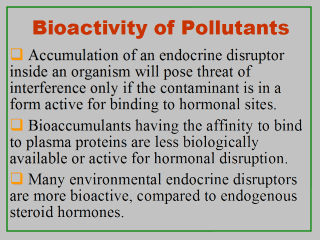| front |1 |2 |3 |4 |5 |6 |7 |8 |9 |10 |11 |12 |13 |14 |15 |16 |17 |18 |19 |20 |review |
 |
One crucial factor
related to bioaccumulation is a pollutantís bioavailability in an
organism. If, as a pollutant, an environmental endocrine disruptor (EED) is
not in a form active for binding to hormonal sites, then its accumulation
inside an organism in the food chain shall not pose any threat of
interference. When an EED is weakly associated with steroid binding
proteins in the blood, then after its uptake much of it may be biologically
available. This usually is not the case with the endogenous steroids which
are mostly attached to binding proteins. Note that an endocrine disruptor
that is more bioavailable tends to be more potent. Once inside an organism, pollutants would travel to organs and tissues via the bloodstream. At any given time, chemicals inside an organism are present either bound or unbound to plasma proteins in tissues and organs. In most cases or fortunately, lipophilic chemicals including most endocrine disruptors tend to travel through the bloodstream bound to carrier proteins or plasma proteins, similar to endogenous hormones. As many endocrine receptors are located within a cell, endogenous hormones or hormone-like exogenous chemicals must be free to pass from capillaries into cells to cause a disruption effect. In any case, it is the unbound fraction of these chemicals that are considered biologically active or available. Proteins that bind to hormones include steroid-hormone binding globulins and non-specific proteins such as albumins. Different endocrine toxicants will have unique or specific binding interactions with different plasma proteins. Thus, the concentration of plasma proteins, the type of proteins, the plasma flow rate, and the binding kinetics between toxicants and their plasma proteins will all affect the amount of a toxicant in the bioactive form. |